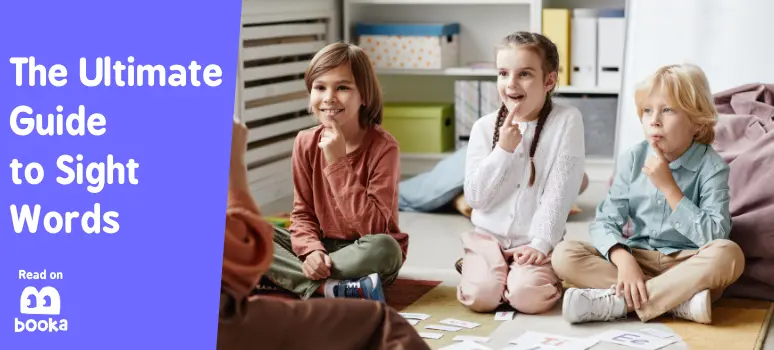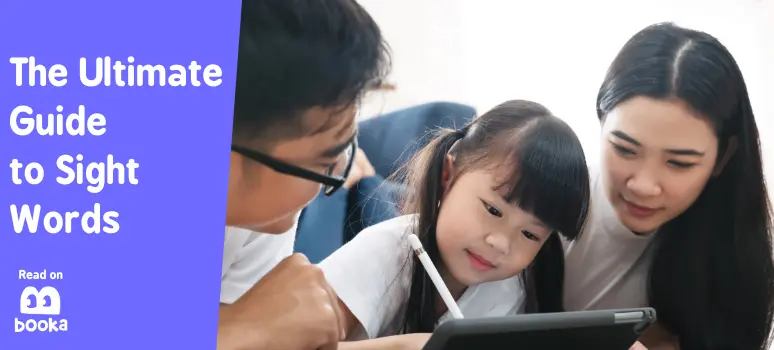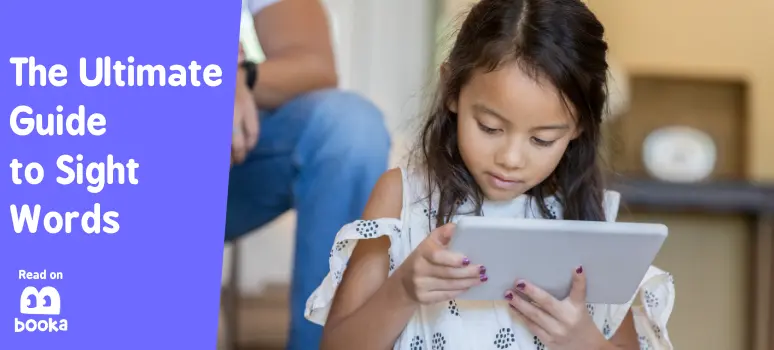Sight words are foundational to reading success and play a crucial role in early literacy. Parents and caregivers can boost a child’s confidence and early literacy skills by incorporating these words into daily reading routines. Therefore, it’s essential that caregivers understand sight words, including what they are, why they’re important, and how to teach them in order to support reading development at home.
This exhaustive guide provides parents and caregivers with all the information and resources they need to understand sight words and help their children master them. In this article, our literacy experts will explain what these words are, provide examples, and offer practical teaching strategies and resources. Whether you’re just starting out with pre-k sight words or looking for advanced techniques for older children, you'll find valuable insights and tips to enhance your child's reading journey.
Ready to learn more about these important words and how to teach them at home? Let’s get into it!
What are sight words?
SIGHT WORD MEANING: common English words that are recognized automatically or “at first sight.” Sight words are often (but not always) irregular words that don’t follow standard phonics rules.
The ability to rapidly recognize these words helps improve reading fluency and comprehension. As a result, young readers can more easily understand and enjoy what they read.
Some examples of sight words include "the," "and," "it," "is," and "to."
How many sight words are there?
The number varies depending on the list that's used. Educators, parents, and caregivers generally use two main word lists.
- Dolch sight words list
- Fry sight words list
Together, these lists encompass hundreds of essential terms children need to know by sight to become proficient readers.
What are Dolch words?
Dolch words are common English words frequently found in children's reading materials. Edward William Dolch compiled the Dolch sight words list in the 1930s-40s.
How many Dolch sight words are there? There are a total of 315 Dolch words, including 220 service words and 95 common nouns. These words are separated into groups by grade level, from preschool through third grade.
For example, below are some examples of Dolch words for different grades.
Preschool
- a
- and
- away
- big
- blue
- can
- come
- down
- find
- for
- funny
- go
Kindergarten
- all
- am
- are
- at
- ate
- be
- black
- brown
- but
- came
- did
- do
First Grade
- after
- again
- an
- any
- as
- ask
- by
- could
- every
- fly
- from
- give
Second Grade
- always
- around
- because
- been
- before
- best
- both
- buy
- call
- cold
- does
- don't
Third Grade
- about
- better
- bring
- carry
- clean
- cut
- done
- draw
- drink
- eight
- fall
- far
The Dolch list is widely used in schools and is considered a fundamental tool in early reading education.
What are Fry words?
Fry words are high frequency words that children should recognize by sight. Dr. Edward Fry created the Fry sight words list in the 1950s and revised it in 1980. The Fry list expands on the Dolch list and includes the most common English words.
How many Fry sight words are there? There are 1,000 Fry words. These words are ranked by frequency and divided into 10 groups of 100.
Fry words are typically taught in order, starting with the first 100 and progressing to the next group once the previous is mastered. Below are some examples of Fry words in the first and last groups.
Examples of the First 100 Fry Words
- a
- about
- all
- am
- an
- and
- are
- as
- at
- be
- been
- but
Examples of the Last 100 Fry Words
- action
- actually
- adjective
- afraid
- agreed
- ahead
- allow
- apple
- arrived
- born
- bought
- British
*Fry words may also be referred to as Fry instant words or Fry 1000 instant words.
Sight Words vs High Frequency Words
While the terms "sight words" and "high frequency words" are often used interchangeably, there is a slight difference between them. But what is the difference between sight words vs high frequency words? Here’s what you need to know.
Both types of words appear frequently in written texts and may be regular (i.e., easily decoded) or irregular (i.e., don’t follow typical phonetic rules). However, high frequency words are not recognized “at first sight,” while sight words are recognized instantly. Once a high frequency word can be identified instantly, it becomes a sight word.

Why are sight words important?
These words are important because they form the foundation for developing more advanced reading skills. In fact, various studies have shown that sight word recognition can help improve reading fluency, comprehension, and confidence.
For instance, a study by Colleen Hayes (published in Education Masters) found that sight word instruction, in conjunction with other literacy instruction, improved literacy skills and reading confidence.
Here’s how the recognition of these words contributes to early literacy.
- Reading fluency - since sight words appear frequently in books and other print, recognizing them instantly allows children to read faster and more smoothly.
- Comprehension - when children can automatically recognize common words, they don’t need to spend so much time and effort decoding. As a result, they can pay more attention to a story’s content and details, allowing them to better understand what they're reading.
- Confidence - the ability to recognize high frequency words effortlessly gives children a sense of accomplishment. This increased confidence encourages a positive attitude towards reading and a greater willingness to read.
As you can see, by focusing on sight word recognition, parents, caregivers, and educators can help children become more proficient, confident, and enthusiastic readers.
The Most Common Sight Words
Below are some of the most common sight words that children will encounter. Mastering these words can significantly improve their reading fluency and comprehension.
- a
- all
- an
- and
- are
- as
- at
- be
- but
- by
- can
- do
- each
- for
- from
- had
- have
- he
- his
- how
- I
- if
- in
- is
- it
- not
- of
- on
- one
- or
- said
- she
- that
- the
- their
- there
- they
- this
- to
- use
- was
- we
- were
- what
- when
- which
- with
- word
- you
- your
To learn how to teach these common words at home, continue reading!
Learning Stages
Learning and teaching sight and high frequency words is a progressive process that evolves as children develop their reading skills. Therefore, understanding the stages of sight word learning can help caregivers and educators tailor their teaching strategies to help kids at different levels.
Let's dive into the various stages to help you better teach these words at home.
Sight Words for Preschool
Children in preschool should learn basic sight words found in simple stories. The goal at this stage is to build a strong literacy foundation and foster a love of reading.
The best way to teach these words to preschoolers is by using playful activities and games designed to make learning fun and engaging. For example, caregivers and educators may use songs, rhymes, and other interactive games to promote word recognition.
The average preschooler should know approximately 20 to 30 basic sight words, including high frequency terms like "a," "the," "and," "is," and "it."
Want to learn more about sight words for preschoolers? Check out - Preschool Sight Words.
Sight Words for Kindergarten
The list of sight words children recognize as they progress through kindergarten should grow. This stage focuses on reinforcing word recognition through more structured activities.
For kindergarteners, fun games and activities, such as bingo, matching games, and reading simple books, are great ways to reinforce word recognition.
By the end of kindergarten, children should know approximately 50 to 100 sight words. This list may include terms like "can," "we," "you," "see," and "go."
Learn more about sight words for kindergarteners in our Guide to Kindergarten Sight Words.
Sight Words for First Grade
First-graders should recognize a broader range of high frequency words and begin to read more complex stories. At this stage, the emphasis is on increasing vocabulary and improving reading fluency.
The best way for first graders to practice these words is through repeated reading, writing exercises, and more advanced games and activities.
Children should recognize about 100 to 200 sight words by the end of first grade. New words at this stage may include "there," "where," "every," "because," and "could."
Sight Words for Second Grade
In the later stages of learning, children should continue to expand their sight word vocabulary and refine their reading skills. At this stage, the focus shifts to achieving fluency and comprehension in more complex texts.
Some of the best ways to enhance recognition for second graders is by having them read more sophisticated stories, complete writing assignments that incorporate these words, and using multi-sensory learning techniques.
Children should know around 200 to 300 sight words by the end of second grade. For example, words like "their," "about," "different," "people," and "other" are introduced.
Sight Words for Third Grade
By third grade, children should be able to read more independently and comprehend a wider variety of texts. Continued sight word mastery at this stage will support these developing literacy skills.
Activities for third graders should focus on integrating high frequency words into more complex reading and writing tasks. In addition, games and activities that allow kids in 3rd grade to use these words in context will help enhance understanding and comprehension.
In third grade, children should know about 300 to 400 sight words. New words at this stage might include "important," "example," "between," "animal," and "family."
4th Grade Sight Words
Fourth graders are expected to read with greater fluency and to be able to tackle more challenging texts. The ability to recognize a vast number of sight words at this stage helps kids transition to more advanced reading materials.
Teaching methods for 4th grade include incorporating these words into comprehensive reading assignments, research projects, and creative writing exercises.
By fourth grade, children should be familiar with around 400 to 500 sight words, including terms like "country," "against," "group," "complete," and "system.”
5th Grade Sight Words and Beyond
Fifth grade marks a significant milestone in reading proficiency, with a strong emphasis on comprehension and critical thinking.
Strategies for teaching high frequency words at this stage include introducing advanced reading materials, having children summarize texts, and using these words in analytical writing tasks.
In fifth grade, children should know approximately 500 to 600 sight words. New words at this level might include "determine," "develop," "knowledge," "understand," and "information."
Ultimately, the goal beyond 5th grade is for children to recognize 1000+ sight words, including all 1000 words on the Fry words list. Kids should be able to recognize all 1000 Fry words by the end of 9th or 10th grade.

How to Teach Sight Words to Kids
Today, teaching sight words to kids requires a combination of techniques that go beyond traditional memorization strategies.
Educators, parents, and caregivers can make learning these words more fun, engaging, and effective by incorporating contextual learning, multi-sensory activities, repetition, phonics, and personalized approaches. This modern method improves word recognition and fosters a deeper love for reading and learning.
The Evolution of Teaching Sight Words
Traditionally, sight word instruction has relied heavily on memorization, with children given a list of words to memorize through repetition. This method helped some kids quickly learn high frequency words. However, it often failed to be engaging and didn't help children understand the context or usage of these words. In addition, educators found that memorization was not effective for all learners.
Now, modern educational theories recognize the limitations of pure memorization and emphasize the importance of understanding over rote learning. Memorization is still necessary, although it should be part of a more engaging strategy involving reading, writing, and play.
Effective Teaching Strategies
Contextual Learning
Instead of isolating words, children learn sight words better when they see them in context. Reading books, sentences, and stories that include these words can help children understand their use.
This method enhances word recognition and can help improve reading comprehension skills.
Multi-Sensory Activities
Engaging multiple senses can significantly enhance the learning process. Here are some practical multi-sensory activities to help you teach your child sight words.
- Interactive Games - playful and interactive games like bingo, memory match, and scavenger hunts make learning fun and interactive.
- Songs and Rhymes - incorporating high frequency words into songs and rhymes can help children better remember these words with the help of rhythm and melody.
- Hands-On Activities - writing the words in sand, tracing them in shaving cream, or creating them with playdough can reinforce learning through tactile experiences.
Multi-sensory activities are beneficial for all younger learners. However, they are particularly useful for teaching sight words to struggling readers.
Repetition and Reinforcement
While memorization should not be the sole focus, repetition is still essential. That’s because repeated exposure to these words helps solidify recognition.
Daily practice with sight words, through reading, writing, speaking, and other engaging activities, will ensure children encounter these words frequently and reinforce their learning.
Integration with Phonics Lessons
Many sight words contain regular phonetic elements. For example, the word "can" can be broken down into its phonetic sounds: /k/, /a/, and /n/.
Teaching children to identify these words using phonetic principles will help them understand the structure of the word, making it easier to recognize and remember. In fact, by incorporating high frequency words into phonics lessons, teachers and caregivers can help children improve their reading fluency and ability to decode new words.
Personalized Learning
All children have different learning paces and styles. Therefore, a personalized learning approach is necessary. To offer a personalized strategy, consider your child’s current reading level and learning style.
Personalized learning strategies are especially beneficial for teaching sight words to struggling or reluctant readers. For example, some struggling readers may benefit from focusing on just a few words at a time.

Tips for How to Teach Sight Words to Struggling Readers
Teaching sight words to struggling readers requires patience, creativity, and the use of various strategies to engage and support them effectively. Here are some tips that can help.
- Use multi-sensory techniques - multi-sensory learning engages more than one sense at a time, helping children to retain and recall information better.
- Incorporate technology - educational apps and online games can make learning these words more engaging for struggling readers. These tools often include interactive and visually stimulating activities that keep children interested.
- Focus on repetition and consistency - regular practice is key to mastering these words. Include these words in daily activities and make practice a consistent part of your child’s daily routine.
- Provide positive reinforcement - encouragement can significantly boost a child's motivation and confidence.
- Engage in play-based learning - incorporating play into learning can make the process more enjoyable and less stressful. For example, use games and activities or interactive storytelling techniques to help your child learn sight and high frequency words.
- Use visual supports - visual cues can help struggling readers remember these words better. For example, consider creating a ‘Word Wall’ that prominently displays the words your child is trying to master or using pictures associated with the words to help with recognition.
The Booka Reading App for Kids - A Must-Have Tool for Teaching High Frequency Words at Home
A children's reading app is essential when teaching sight words to kids at home. Reading apps for kids, like Booka, offer personalized, interactive, and engaging reading resources that incorporate sight words. They also provide multi-sensory engagement and stories that integrate high frequency words with phonics instruction. Best of all, the children’s books on Booka allow your young learner to practice these words anytime, anywhere they want!
With Booka, you have the resources to make sight word practice an enjoyable part of your child’s daily routine, setting the stage for lifelong literacy and a love of reading.